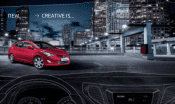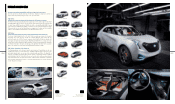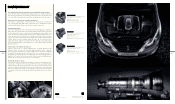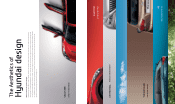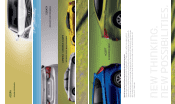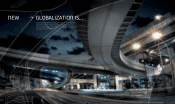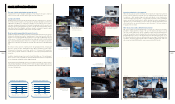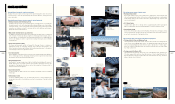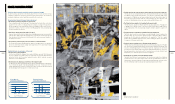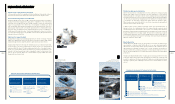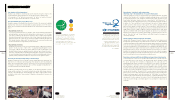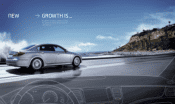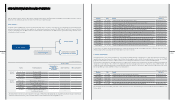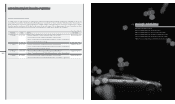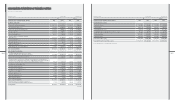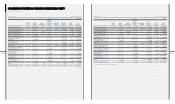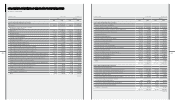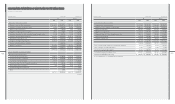Hyundai 2010 Annual Report Download - page 27
Download and view the complete annual report
Please find page 27 of the 2010 Hyundai annual report below. You can navigate through the pages in the report by either clicking on the pages listed below, or by using the keyword search tool below to find specific information within the annual report.
U.S. Department of Energy test operation (Tucson fuel cell vehicle)
Domestic monitoring project / mounting of own fuel cell system
Independent development of fuel cell bus
Independent development of fuel cell hybrid
Participation in California fuel-cell partnership (Santa Fe fuel cell vehicle)
Pollution-free hydrogen fuel cell vehicles
Water is the only emission of a hydrogen fuel-cell vehicle, which gets its energy by reacting
hydrogen with oxygen from the air. Hydrogen can reduce dependence on fossil fuels by
enabling the production of energy from diverse sources including solar heat, wind power and
nuclear power. With twice the efciency of internal combustion engines, hydrogen powerplants
can effectively use natural energy. Hyundai has beaten the traditional foe of hydrogen vehicles
– cold weather – by developing technology that enables ignition and operation at -20°C.
Other innovations have created the ability for cost-effective mass production and signicant
reductions in fuel cell stack size and weight.
To address safety concerns, Hyundai is employing collision tests and simulated res on
hydrogen vehicles. As a leading global automotive company, Hyundai is passionate about
environmental protection and condent of the necessity of eco-friendly vehicles. Driven by
this passion, Hyundai developed a third-generation Tucson hydrogen fuel cell vehicle that can
travel up to 650 kilometers on one charge in 2010. The Tucson fuel cell vehicle has a top speed
of 160 km/h and could start at -25°C. As of 2011, 48 hydrogen fuel-cell vehicles will be driven in
the Seoul metropolitan and Ulsan regions for road-testing; small-scale production and practical
application is planned to begin in 2012.
Blue-On Electric Car
Hyundai debuted the Blue-On electric car, which was the rst Korean car capable of high-
speed operation, in September 2010. The Blue-On electric car can be driven approximately
140 kilometers on a single charge and has superior performance, with a maximum speed of
130 km/h and zero-to-100 km/h acceleration of 13.1 seconds. In addition, the key parts are
all produced within Korea, providing a foundation for technological development of electric
vehicles. The high-voltage parts use a complex safety design so that both safety and reliability
are provided.
Hyundai is providing 30 Blue-On vehicles to public agencies and local governments for initial
testing from August 2010 to August 2012, and beginning in January 2011, will provide 250
more units to government ofces and corporations for diverse uses including commuting and
short-range city driving, thus establishing a rm basis for the commercialization of electric
vehicles.
Hyundai creates a green future for planet Earth
Life is good with a car, but it is meaningless without a healthy planet. Hyundai will continue to
devote unreserved investment and research to development vehicles our planet needs.
Environmental management based on Blue Drive
Hyundai, beginning with the FGV-I in 1995, continued green growth with the proclamation
of global environmental management in 2003 and the establishment of the environmental
technology center in 2005. We have been striving constantly to reduce the environmental
impact of our automobiles. These efforts led us to development eco-friendly cars, which
make the Blue Drive strategy, launched in 2009, more visible. Blue Drive has the objective of
producing value in harmony with society and the global environment, combined with the basic
automotive value of mobility based on the Hyundai management concept of contributing to a
fruitful human life through automobiles. Going forward, Hyundai will continue to do its utmost
to create a future where people, society and Earth coexist in harmony, through environmental
management based on Blue Drive.
Hybrid cars that respect the Earth
Hyundai Motor Company started distributing hybrid vehicles with the test driving of 50 Click
hybrid cars in 2004 and with the domestic production of key parts in 2005. In 2008, Hyundai
had provided approximately 1,400 Verna hybrids to public and educational institutions.
In 2008, using homegrown technologies, the LPi hybrid car was successfully developed which,
for the rst time in the world, combined LPG fuel with an electric motor. Commercialized
beginning in 2009, the Avante LPi hybrid combining practicality with eco-friendly performance.
In 2011, the Sonata gasoline hybrid, with superior fuel economy and performance, was
released to the American and Korean markets, expanding the market to mid-sized cars. From
2012 on, we will accelerate R&D on the commercialization of plug-in hybrids that can be
charged with household electricity.
1 Diesel hybrid concept car: i-ow
2 Avante LPi (LPG injection) hybrid
3 YF Sonata hybrid
Hydrogen-fuel-cell Tucson 1
Hydrogen-fuel-cell concept car Blue2 2
Environmentally-friendly electric car Blue On 3
Hybrid car development performance and future plans
Ensuring mass-production
technology (test production)
HEV First concept car
developed
County HEV developed
Click HEV is test-driven
Production system constructed
(Key parts produced in Korea)
Verna HEV test-drive
Elantra LPi HEV mass
production
Hybrid city bus
distribution
Model diversication
(expansion of exports)
Sonata HEV mass
production
Mass-production of
plug-in hybrids
Roadmap for development of hydrogen fuel cell vehicles
Basic technology research
Prototype development
Initial small-scale application
Small-scale production
of fuel-cell vehicles
Test distribution in
northern Europe (4 countries)


